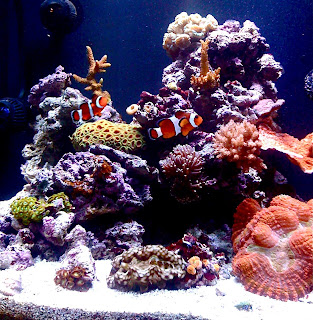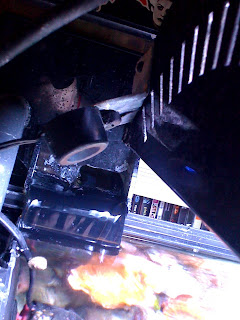
As May 1st came and went, as did the inevitable moving day which required also moving the Nano Aquarium. Although the new house and the tank relocation was literally down the street and around the corner, the amount of precision, patience and planning required to effectively move the tank was enormous. Moving the 29g cube proved quite flawless with the whole mission wrapping up in about 1.75 hours.
Although the steps required to get the tank and its huge amount of contents from point A to point B seemed daunting, but with the help of another reef-keeper, I was able to quickly move everything in two trips. In this time I also had to re-aquascape, place coral, and transfer all the inverts and fish. All of this which was done in a careful manner to avoid shock, and re-cycling the tank ecosystem.
The motions needed to execute the move can be categorized into 4 groups. I hope these steps will help anyone who has the unfortunate but achievable task of moving a nano size aquarium in the future.
#1. Preparation: The preparation consisted of a few simple tasks.
a) About 9 gallons of salt water (30% of the system) was prepared a couple days before the move in the same way a typical water change would be prepared. (Heat, water motion, bubbles for PH balance).
b) A location was chosen in the new house before the move was started so carrying times and the transfer required no on the fly decision making.
c) Purchase, (or in this case borrowing) of several clean buckets for transfer of water, and live-rock.
d) Purchase of large ziplock (or no-name) freezer bags to hold all the corals and fish which differ in size and shape.
e) Packing of any additives, food, supplies, tools, test kits,

etc. and anything else that can be moved before the tank and livestock itself. This saves time leaving only the bare essentials which will be moved all at once.
#2. Livestock Removal:
a) This step requires the diligent bagging of coral. By leaving the tank running the water could still circulate and filter as all 20+ species of coral were carefully removed from the system and placed in bags containing tank water.
b) The larger inverts, crabs and two clownfish were left in the tank for removal during the water and rock removal stage.
c) Lastly the cheato was removed and bagged also to avoid die-off.
#3. Water and rock Removal: With the tank now "coralless" the removal of rock and water began. The filtration and water motion was left on until now so the water was still crystal clear. These simple steps are in an attempt to preserve as much of the mature water without stirring up sediment or exposing live-rock.
a) As the water was syphoned into buckets, the live-rock was added into these buckets. This ensured the cured live-rock only leaves the water for a second or two before being fully submerged back in the bucket. This process requires careful removal to avoid disturbing the sand bed releasing semi consumed nitrates and crud into the water column. Although live-rock can survive exposed for quite some time. I chose to keep every piece submerged for the entire process keeping the bacteria, worms, pods, and coralline algae alive again in an attempt to avoid the mess of another tank cycle.
b) The trick for the next step was to first stop the syphon at about 60% to remove the fish and inverts. With the majority of the rocks and water gone it is much easier to catch the quick fish limiting the amount of induced stress.
c) As the water level approached the bottom of the tank, it was essential leave at least 1 inch of water in the tank and not touch any live-rock that was anchored in the sand bed. This keeps the water clear and anaerobic bacteria deep in the bed undisturbed further avoiding a second cycle.
#4. Relocation of Tank and Equipment: With all equipment in a milk crate, all livestock bagged and stored in containers and both the rock and water filling another several buckets, the move was about to begin. Luckily the tank and stand fit perfectly into the backseat of a VW Jetta and we were on the road.
a) With the live sand, an inch of water, and about 6lbs of liverock sitting on the tank base, the
empty 29g Biocube was a bit heavy but nothing two lifters could not handle with ease. While manually supporting the base of the tank, we quickly moved the tank, stand, equipment, livestock, and any other loose ends in two trips.
b) The aquarium was carried into the new house carefully to avoid disturbing the sand bed and base live-rock, and placed on the stand.
c) The heater, powerheads, skimmer, and fuge light were all in place and the aquarium was positioned levelly and appropriately to avoid direct sunlight and open vents, while meeting all the other aesthetic and practical criteria of home aquarium placement.
#5. The Aquascape and Re-addition of Tank Contents: At this point the coral and livestock have been in bags for about 45 minutes. To avoid over-stress, it was time to refill the tank and get the creatures back into their environment as soon as possible.
a) Instead of pouring water into the tank which would create turbulence and disturbance of the sand bed, an extremely clean small glass plate was placed on the sand bed, and water was pumped from the bucked into the tank landing smoothly on the center flat plate surface. The pump and plate are extremely effective in diffusing the water current allowing the water to fill the tank quickly without creating unwanted current and disturbance. Although it would be
much quicker to pour the water directly into the tank, this delicate approach is just another quick fix to keeping the water pure and the sand bed untampered with.
b) As the water level rose, the rocks were added back into the crystal clear tank in the desired aquascape (Which turned out almost identical to the previous scape, with minor adjustments
for more SPS additions and less wasted vertical rock surface.)
c) Heres where the preparation of several gallons of salt water comes into play. To avoid pouring the polluted bag water containing the stressed fish, coral and inverts into the tank,
fresh mixed water was added which worked out to be about a 25-30% water change. It is incredibly important to not overlook this step. If all the water that has been sitting unfiltered for about an hour with coral chemicals and ammonia was poured back into the tank it could create a big mess possibly resulting in a quick crash or damage to the tank's ecological balance and all its contents.
d) With the tank almost 100% full the pumps and skimmer were turned back on and the fish bags were acclimatized to the current water temperature. Finally the fish were released happily into the system with no signs of shock or irritation.

e) Next all coral was carefully placed in the desired locations which is quite similar to the previous setup. A Zoa and Acan garden was arranged, and a small forest of SPS frags were placed near the top of the rock structure. Although an attempt to place the coral properly was made it was more important to get everything back in the system quickly, providing an opportunity to aesthetically arrange the specimens would follow during the next days.
1 hour and 45 minutes later the tank was looking better than ever with the coral all in place and the water remained completely clear for the entire process. The halide lamp was remounted
which turned on the next morning to light a relatively undisturbed system full of open healthy corals and a seemingly undisturbed ecosystem.

Strontium, Magnesium, Calcium, and Alkalinity tests were taken immediately for a reference to readjust the parameters back to normal over the next week or two.
A week after the move the system was still incredibly stable seeing absolutely no rise in ammonia, nitrite or nitrate and even the coralline algae was completely unaffected. Some minor diatom growth was seen for about 1 week after moving day but has now disappeared completely 3 weeks later. All corals are still growing rapidly with the success of this system unrivaled to any salt water experience in my past.
Unfortunately and regretfully during the intense time sensitive process I neglected to take mny pictures of the steps along the way but I hope this article is helpful.
Sorry for the "long winded-ness" of this post but I feel the strategy and methods used to seamlessly relocate a fragile reef system are essential to any aquarist who may need to undergo a move.
 An actinic light was added to the system, purely to enhance the colors of the inhabitants. It also helps get the photo-period up and running faster without having to run the 250 watt Metal Halide light 12 hours a day.
An actinic light was added to the system, purely to enhance the colors of the inhabitants. It also helps get the photo-period up and running faster without having to run the 250 watt Metal Halide light 12 hours a day.
 That is all.
That is all.


















 the purchase of any marine livestock be it coral inverts, or fish.
the purchase of any marine livestock be it coral inverts, or fish.





























